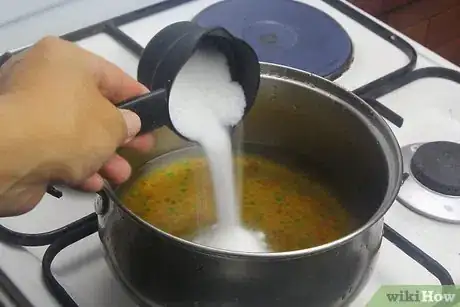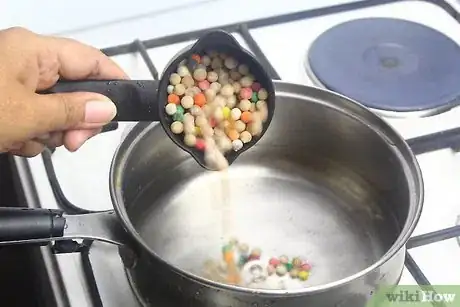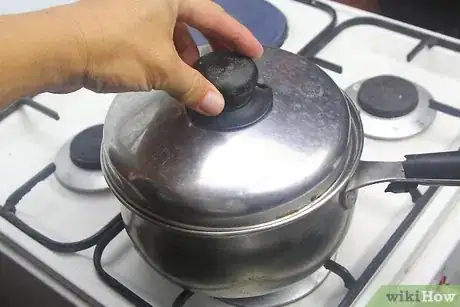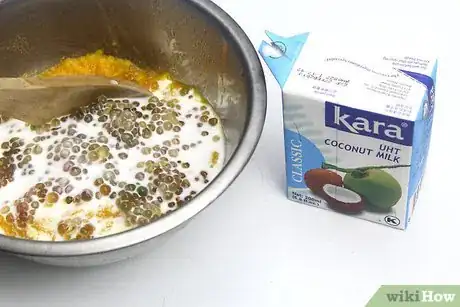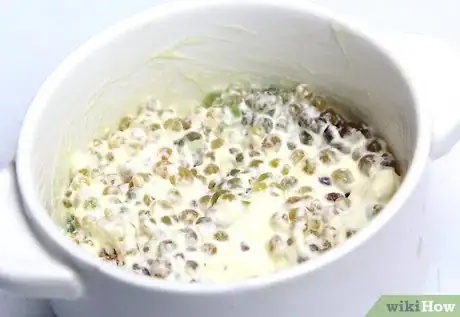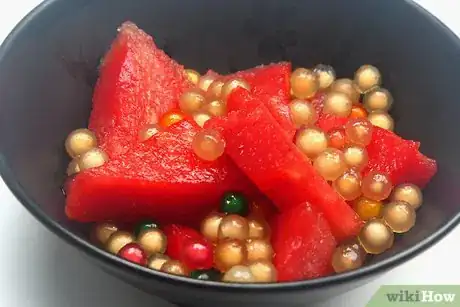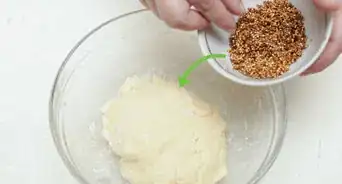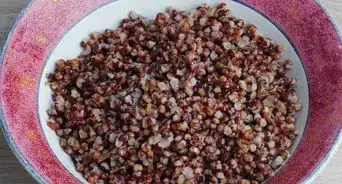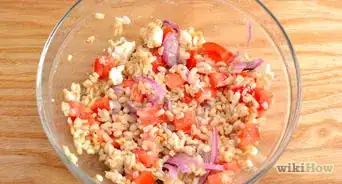This article was co-authored by wikiHow Staff. Our trained team of editors and researchers validate articles for accuracy and comprehensiveness. wikiHow's Content Management Team carefully monitors the work from our editorial staff to ensure that each article is backed by trusted research and meets our high quality standards.
There are 10 references cited in this article, which can be found at the bottom of the page.
This article has been viewed 31,430 times.
Learn more...
Sago is an important food for the people of New Guinea, but this starchy treat is now sold throughout the world. Sago often comes in pearls that are cooked to make pastes, pancakes, or small balls. It works great in puddings and drinks. Boil normal sago to prepare it or soak big sago pearls throughout the day (for about 6 hours) so its ready in time for dinner. Mix sago with all kinds of fruits to create new variations of sago dishes.
Ingredients
- 1 cup (237 ml) uncooked sago pearls
- 6 cups (1.4 L) water
- ½ cup (118 ml) granulated white sugar
Serves 5.
- 5.3 oz (150 g) big sago pearls
- 2.1 qt (2 L) water
- 6.8 fl oz (200 ml) water
Makes 1.3 lbs (600 g).
- 2 cups (473 ml) of cooked sago (chilled)
- ¾ to 1 cup (177 to 237 ml) of pureed mangoes (chilled)
- ½ to ¾ cups of coconut cream (chilled)
- Sugar (to taste)
- Chopped fresh mangoes (optional)
- Crushed ice (optional)
Serves 4 to 6.
Steps
Boiling Sago
-
1Bring water to a boil in a large pot. Measure out 6 cups (1.4 L) of water and pour it into a large pot. Place the pot on your stove top and bring it to a boil over high heat. Once boiling, reduce the heat to medium.[1]
-
2Cook the sago over medium heat for 30 minutes. Pour 1 cup (237 ml) of sago into the boiling water. Cover the pot with a lid and set a timer for 30 minutes. Stir the pearls about once every 10 minutes.[2]Advertisement
-
3Add sugar to the water and sago. Pour in a half cup (118 ml) of granulated white sugar into the pot and stir the contents thoroughly. Now you're ready to lid the pot and reset the timer for 20 minutes. Stir the pearls every 10 minutes.
- If the water boils low, add more. The sago should be submerged in water at all times.[3]
-
4Turn off the heat, cool, and enjoy. After your 20 minute timer rings, turn off the heat. Rotate the pot to a cool burner. While keeping the pot lidded, allow it to cool until it reaches room temperature. Transfer the sago to serving bowls and enjoy.[4]
Soaking Big Sago
-
1Add sago to a large pot of boiling water. Pour 2.1 qt (2 L) of water into a large pot and place it on a burner of your stove. Set the burner to high and boil the water. Add 6.8 fl oz (200 ml) more water to the pot along with 5.3 oz (150 g) of big sago pearls.[5]
-
2Cook the sago on low heat, uncovered, for 15 minutes. Return the water to a boil after adding the sago, then reduce the heat to low. Keep the lid off the pot during this time and stir the sago occasionally with a slotted spoon.[6]
-
3Cover and soak the sago for 1 hour and 30 minutes. After the sago has cooked on low for 15 minutes, set the burner to high and return the water to a boil. Once boiling, turn off the heat, cover the pot with a lid, and let the sago soak for one and a half hours.[7]
- Whenever boiling the sago, stir it occasionally with your slotted spoon to prevent it from sticking to the bottom of the pot.[8]
-
4Return the water to a boil and soak the sago for an hour and 30 minutes. You'll end up repeating this soaking process four times total.[9] Set the burner to high, bring the water to a boil, turn off the heat, then cover and soak the sago for 1 hour and 30 minutes.
- Because the process of reheating and soaking the sago requires little attention, it helps to have other chores, errands, or activities planned.
- When all is said and done, you'll have soaked the sago in this fashion for a grand total of 6 hours (or four total soaking periods each one and a half hours long).[10]
-
5Strain and rinse the sago, then serve it as desired. Place a colander in the sink and strain the water from the sago. When the water has drained, rinse the sago thoroughly under cool water to reduce starchiness. Now the sago is ready to eat.
Making a Mango-Sago Dessert
-
1Combine the cooked sago and pureed mango in a mixing bowl. Pour the cooked sago and pureed mango into your mixing bowl. Use a utensil, like a wooden spoon, to mix these ingredients until they are evenly distributed.[13]
-
2Stir coconut cream into the sago and pureed mango. When the ingredients are evenly mixed, stir in the coconut cream. Mixing the coconut cream into the sago and pureed mango is the easiest way of making a big batch of this dessert.
- To improve the presentation of this dessert, ladle the mixed sago and mango puree into serving bowls and drizzle coconut cream on top.[14]
-
3Add toppings, if desired, and enjoy. A few chunks of cut mango nested on top can also add a lot to the look of this dish. To accent its tropical features, you might want to add some coconut shavings. Experiment freely with toppings until you find your favorite combination.[15]
Trying Other Sago Dishes
-
1Whip up a sweet potato and sago dessert. This sweet, relatively healthy dessert can be made in less than 30 minutes. The pandan leaves used in this recipe will impart a flavor similar to vanilla to the dish, giving the boiled-soft sweet potatoes an almost candy like quality.
-
2Try Asian style coconut sago. This version of sago is especially popular in Malaysia and Japan. If you’re a sushi fan, you may have even seen this dish before, as it’s a popular side with sushi. Sago pearls in a sweet cream served with fruit makes for a great summer treat.
-
3Mix cold fruit in with chilled sago. Fresh fruit and sago go together like peas in a pod. The smooth texture of the sago complements the similar quality of most kinds of fruit. This is an excellent healthy snack for kids who are picky when it comes to fruit.
- Traditionally, fruit like watermelon, honeydew, and mango are used in recipes like this, but adding other kinds, like grapes and berries, might make it even tastier.[16]
-
4Enjoy a hearty breakfast with flaked oatmeal and sago. This is a great breakfast meal that’s particularly easy if you’ve stored away some sago in simple syrup. Cook oatmeal as you would normally. When it’s done, stir as many sago pearls as you want and enjoy.[17]
- Be careful when adding sago pearls stored in simple syrup. Adding too many could result in your oatmeal becoming too sweet.
- Mix in a few sliced bananas, a dash of vanilla extract, and a light sprinkling of nutmeg to create add some flavor to your sago oatmeal.[18]
Warnings
- Whenever cooking, use caution. Improperly using kitchen tools or heat sources (like your stovetop), could result in harm or property damage.⧼thumbs_response⧽
Things You’ll Need
Boiling Sago
- Pot (medium to large sized)
- Timer
- Wooden spoon (or similar stirring utensil)
Preparing Big Sago
- Pot (large sized)
- Slotted spoon (or similar stirring utensil)
- Timer
- Colander
Mango-Sago Dessert
- Mixing bowl (large sized)
- Serving bowls
- Ladle
- Wooden spoon (or similar stirring utensil)
References
- ↑ http://panlasangpinoy.com/2014/09/13/cook-sago-pearls/
- ↑ http://panlasangpinoy.com/2014/09/13/cook-sago-pearls/
- ↑ http://panlasangpinoy.com/2014/09/13/cook-sago-pearls/
- ↑ http://panlasangpinoy.com/2014/09/13/cook-sago-pearls/
- ↑ http://mykitchen101en.com/how-to-cook-big-sago-pearls-whole-chewy/
- ↑ https://www.youtube.com/watch?v=TEVA8jBTsO0&feature=youtu.be&t=28s
- ↑ https://www.youtube.com/watch?v=TEVA8jBTsO0&feature=youtu.be&t=43s
- ↑ http://mykitchen101en.com/how-to-cook-big-sago-pearls-whole-chewy/
- ↑ https://www.youtube.com/watch?v=TEVA8jBTsO0&feature=youtu.be&t=1m21s
- ↑ http://mykitchen101en.com/how-to-cook-big-sago-pearls-whole-chewy/
- ↑ https://www.youtube.com/watch?v=TEVA8jBTsO0&feature=youtu.be&t=1m33s
- ↑ http://mykitchen101en.com/how-to-cook-big-sago-pearls-whole-chewy/
- ↑ https://casaveneracion.com/sago-tapioca-pearls-and-mango-dessert-2/
- ↑ https://casaveneracion.com/sago-tapioca-pearls-and-mango-dessert-2/
- ↑ https://casaveneracion.com/sago-tapioca-pearls-and-mango-dessert-2/
- ↑ http://www.spicingyourlife.in/2015/06/sago-fruits-pudding.html
- ↑ http://www.bawarchi.com/recipe/rose-syrup-sago-and-oats-kheer-oezqDUdehibec.html
- ↑ http://www.jehancancook.com/2011/01/the-most-important-meal-of-the-day/
About This Article
To cook sago, boil water in a large pot, reduce the heat, and add sago. Cover the pot and set a timer for 30 minutes, stirring the sago every 10 minutes. Once the 30 minutes have passed, add sugar to the pot and reset the timer for 20 minutes. When the timer rings, turn off the heat and allow the sago to come to room temperature before eating. To use your sago in a dessert, mix the cooked sago with pureed mango, stir in coconut cream, and enjoy! For tips on how to cook big sago, keep reading!


